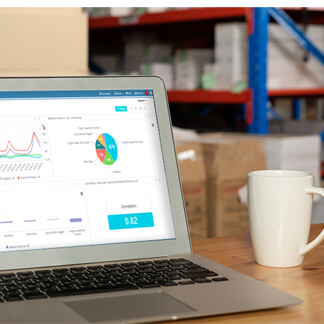Digitally Mature Manufacturers Have an Edge. How Digitally Mature Are You?
Operating in a COVID-19 world amplifies all of the challenges you face when it comes to growing your business profitably. Mostly, this comes down to uncertainty.
- Where will demand go next?
- How will your customer base continue to change?
- What emerging needs should you be addressing through new offerings and new channels?
Getting the answers to these questions right can help you win. And technology can give you the edge to know where your best growth opportunities exist and help you produce and deliver against them profitably. Specifically, leveraging the right digital technologies in three areas of your business—sales and marketing, engineering, and operations—helps ensure the best combination of insight and capability to gain competitive advantage. Technologies can help drive improvements of 5-15% in key performance metrics, a difference that can make or break your success in today’s complex operating environment.
Ask these seven questions to learn how digitally savvy you are—and where you may need to up your technology game.
Sales and Marketing
1. Do you leverage insights to spot your best opportunities?
With demand all over the place and customers bouncing between canceling orders then overcorrecting in the next breath, forecasting became pretty much a crapshoot in 2021. Those companies that got it right leaned into their technology like never before. They relied on their CRMs to help manage relationships and transactions. But they went further, using insights from the system to tune into trending products and to look for the customers, segments, industries, and geographies representing the best opportunities for growth.
If you’re already using your CRM in this way, you will have an edge as markets and demand continue to fluctuate. You can further sharpen that edge with IoT data. Connected products give you a wealth of information for better understanding product usage. This can translate into well-timed recommendations for parts replacement and/or follow-on services. It can even be used to innovate entirely new products.
2. How quickly do you move from inquiry to quote to cash?
Of course, finding the opportunities is one thing. Going from lead, to sale, to cash is another. The better you are at streamlining and fast-tracking this cycle time, the more quickly you can build your topline. And the right configure, price, quote (CPQ) software can make all the difference.
We worked with one heavy industrial engineered-to-order company where lead times were becoming a major obstacle with 75% of the time tied up in upfront processes including order acquisition, engineering, customer approval, and drafting/modeling. Switching to a value stream structure aligned with customer sets and implementing new quoting capabilities and workflow management tools cut lead times by 40%, driving greater customer satisfaction in the process.
Engineering
3. How connected are you?
Engineering technologies can reduce lead times and drive product value—both of which support more sales. IoT and IIoT data are critical inputs to your process, helping you design products that consumers want and that are cost-effective to produce—the very definition of a win. If you make connected products on a connected factory floor, you will have an edge when it comes to finding this sweet spot.
4. How quickly can you act on insights?
If you leverage a product lifecycle management (PLM) system with integrated drawing software and 3D modeling capabilities, you can quickly implement design improvements and validate their effectiveness. You can automatically generate bills of materials (BOMs), ensuring efficiency and reducing the potential for errors that can quickly turn a profitable project into a loss. Additive manufacturing—3D printing—is another way to turn ideas into prototypes fast while eliminating the costs involved in creating expensive aluminum molds.
5. Do you use technology to simplify and ensure accuracy?
Standardisation of products and components reduces the potential for errors while driving efficiencies. For example, a configurator that automates and controls option selections can help reduce product variants. By maintaining design simplicity and avoiding costly mistakes, you can expedite production processes, slashing lead times and getting your products to market faster.
Operations
6. Are you digitally positioned to execute efficiently and at your lowest total cost?
Even if you know what consumers want and how to design those products for manufacturing, you can still fall down in the final mile if you don’t have the operational capabilities to deliver on your promises. Keeping constant tabs on performance and production targets is essential, especially as you continue to manage through the lingering effects of COVID-19. Technologies that can help include:
- Capacity planning and finite scheduling tools to understand what is available to promise.
- Digital KPI management tools to keep everyone focused on hitting goals.
- Operations technology data, available through IIoT connectivity, to understand performance and uncover the root causes of production problems.
- Computerised Maintenance Management Systems (CMMS) to circumvent problems that could shut down equipment.
- Warehouse Management Systems (WMS) to keep products moving to customers’ doorsteps.
- Advanced analytics to track, monitor, and improve total cost to serve.
- A comprehensive digital management system that aggregates data from your top floor to your shop floor to give your complete performance picture and help you proactively resolve operational issues.
We helped a leading manufacturer of wind towers use the Dploy Solutions suite of manufacturing tools with a focus on KPI management to improve quality, on-time delivery capabilities and expedite lead times. By automatically integrating data and providing the ability to easily track all operational metrics, the company was able to achieve its goals and ultimately improve operating profit by 20% in just three years.
7. Is automation in place or at least on the table?
Given that COVID-19 has compounded the tight labor market and amplified staffing challenges, automation is becoming more important, particularly to manufacturers that have meaningful equipment and facility capacity to spare, but not enough human capacity to get the job done. The good news is that even as the need is rising, technologies are becoming more accessible and more affordable.
At a minimum, you should at least be exploring your options and weighing the costs of automation. Look at implementable technologies that can dramatically reduce the need for people (think robots and co-bots). Focus on automating non-value-added activities first.
We helped a potato processing plant capture $1.6 million in savings on its production and packing lines by introducing automation to eliminate monotonous material handling and packaging work that was continuously hard to staff. By prioritizing the right areas for automation, the company solved both production and human capital problems and put itself in a better position for growth.
Give yourself a technological advantage.
Uncertainty and a more accelerated pace of change has made profitable growth more difficult for all manufacturers to achieve. Your business needs every edge it can get. Upgrading your digital technologies may be one of the best ways you can stay on top of changes, pinpoint opportunities, and execute on them quickly in our current business environment.





